
Home - Search - Browse - Alphabetic Index: 0- 1- 2- 3- 4- 5- 6- 7- 8- 9
A- B- C- D- E- F- G- H- I- J- K- L- M- N- O- P- Q- R- S- T- U- V- W- X- Y- Z
CXV
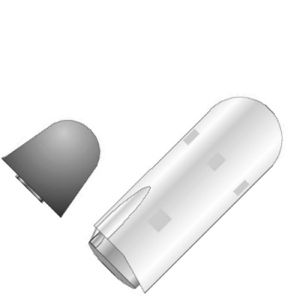 S1CXV Credit: Mark Wade |
AKA: CEV t/Space;Crew Transfer Vehicle. Status: Study 2012. Gross mass: 5,000 kg (11,000 lb). Unfuelled mass: 3,700 kg (8,100 lb). Height: 4.50 m (14.70 ft). Diameter: 4.20 m (13.70 ft).
A scaled up version of the Air Force's Corona capsule would have delivered four crew to orbit at a cost less than 1/20 that of NASA's CEV.
On 1 September 2004, Transformal Space Corporation LLC (t/Space) was named by NASA as one of 11 companies to conduct six-month, $ 3 million studies on Crew Exploration Vehicle concepts. t/Space's partners included Burt Rutan's Scaled Composites, which had developed the Tier One system that made the first civilian spaceflight; and AirLaunch LLC, which had a unique low-cost Quick Reach rocket system under development for DARPA. t/Space was one of only two companies to receive a follow-on $ 3 million demonstration contract. Three test drops of a subscale booster in May-June 2005 proved the unique air-launch approach proposed. A full-scale mock-up of the planned manned space capsule was built, and engine tests of the booster began in May 2005.
If t/Space had been given a go-ahead for NASA's Crew Exploration Vehicle requirement in 2005, they promised an uncrewed demonstration flight by the summer of 2008, with a crewed flight in summer 2009. This would have eliminated the gap between the retirement of the Space Shuttle in 2010 and the initial flight of the CEV. Instead NASA plunged ahead with its own CEV design, which promised to lead to a gap of many years, leaving America without a manned spaceflight capability. Although NASA did not proceed with the low-cost concept, it certainly seemed the logical candidate for a tourist-to-orbit follow-on to Tier One.
t/Space's partners demonstrated the technology that would ensure that it could deliver a launch system that would deliver a crew of four to orbit at a cost of $20 million per launch within three years of go-ahead. This was less than 10% the cost and half the time that NASA planned to spend on its own CEV approach. Naturally this was of no interest to NASA and further contracts were not forthcoming.
The t/Space CXV and Earth-to-orbit system would have dramatically lowered the cost of human space flight, and allowed NASA to focus its scarce resources on exploration beyond low Earth orbit, while opening space to the public for the first time. In time, a robust market for personal space flight would lead to the development of other vehicles and destinations in orbit fully funded by the private sector -- of which NASA could take advantage.
The t/Space system consisted of three components: the Crew Transfer Vehicle (CXV) space capsule, the Quick Reach 2 two-stage booster, and the Very Large Aircraft (VLA) launch aircraft. The CXV capsule was reusable, requiring minimal refurbishment. Air launching eliminated the need for a fixed ground launch complex. The inherent simplicity of the expendable booster significantly lowered manufacturing costs. t/Space offered rapid prototyping under a fixed-price contract to NASA. Burt Rutan's Scaled Composites would build the structure of the CXV, and t/Space and other contractors would integrate the capsule with avionics, life support, on-orbit propulsion and other systems.
Crew Transfer Vehicle (CXV)
The CXV was designed to do only one thing -- take people to and from low Earth orbit. The CXV was a simple capsule design based on the Discoverer or Corona reentry vehicles used by the American intelligence community to return film from orbit. The aerodynamics and flight characteristics of the capsule were well known, with more than 400 reentries having taken place over a period of more than 20 years.
The CXV's shape provided for "carefree reentry" of the capsule. Similar to a badminton shuttlecock, the spacecraft automatically righted itself as it descended into the atmosphere regardless of its initial orientation due to the aerodynamic loads. As a result, neither human nor computer intervention was needed to stabilize the vehicle in the event that the vehicle was not perfectly aligned for reentry. With a center of gravity slightly offset from the vehicle centerline, descent loads could be kept below 4 Gs, safe enough for astronauts returning from long-duration stays on the International Space Station or for injured crew. The capsule's thermal protection system, comprised of a double layer of SIRCA tiles developed by NASA Ames Research Center, shielded the vehicle and crew from the heat of reentry.
Once low in the atmosphere, three Apollo parachutes deployed to soften the landing into water. The landing site could be ensured by propulsive maneuvers during the vehicle's initial descent which would provide a crossrange of more than 740 km. Water landing allowed the aeroshell to remain unpenetrated by landing gear, airbag doors, or hatches. Each passenger would wear a parachute for personal bailout in case of a catastrophic failure of all three parachutes.
Air launching from an altitude of 7,600 m provided far safer abort modes than a ground launch. In the event of a booster failure, the capsule would already be high enough for parachute deployment. By comparison, any ground-based system would require an expensive expendable abort tower to pull the capsule away from the booster during the initial phases of flight. The booster's simple design resulted in far fewer failure modes than conventional systems, again greatly enhancing reliability of the system and survivability of the crew. The coaxial pintle engine design had only one moving part downstream of the fuel and oxidizer flow valves -- there were no turbopumps or pressurization systems.
A problem with the use of a Discoverer-type capsule for crew re-entry had always been that the direction of G-forces during launch and re-entry were opposite. t/Space solved this through use of an innovative seat design - a type of suspended semi-rigid hammock - that could rotate 180 degrees within two seconds in order to keep the astronaut correctly oriented regardless of g-force direction. The prototypes were one tenth the mass of space shuttle seats and tested up to 13 G's.
Quick Reach 2
The Quick Reach was a low-cost space booster already under development by AirLaunch LLC under an $11.3 million contract in Phase II of the Falcon program run by the Air Force and the Defense Advanced Research Projects Agency (DARPA). The program's goal was a booster able to loft small spacecraft for less than $5 million per launch, and with just 24-hour notice.
The Air Force / DARPA selection of AirLaunch as one three Phase II winners enabled the company to move forward on engine development and air drop techniques. The goal was a flight test of the AirLaunch QuickReach booster in 2007.
The QuickReach was a two-stage vehicle using propane and liquid oxygen. Initial tests of second stage ignition began in early May 2005.
Scale-up of the QuickReach design resulted in the Quick Reach 2 for the NASA CEV requirement.
Very Large Aircraft (VLA)
t/Space collaborated with Scaled Composites to design a custom Very Large Aircraft (VLA), which would carry the CXV manned space capsule and the QuickReach 2 booster to launch altitude, an extension of the White Knight design used to launch SpaceShipOne. An alternative to the VLA would be to modify and extend the landing gear of a Boeing 747 to provide sufficient ground clearance to carry the CXV and booster.
The t/Space version of air launch provided only modest performance gains compared to a ground launch (savings of 335 m/s to 550 m/s in booster delta-V requirements). The major rationale for an air launch were instead safety, simplicity and flexibility. Crew safety was enhanced because abort-at-ignition was easier when the capsule was already high enough for parachute deployment, instead of an expensive and complex on-the-pad abort tower system. Air launch allowed simpler engines in the booster, which did not have to be designed to operate at both sea-level air pressure and at altitude. Launch from 7600 m altitude permitted the engines to be run at a maximum of 10 atmospheres, which in turn meant tank pressures did not to have to exceed 14 atmospheres. This in turn meant that vapor-pressure (Vapak) pressure-feed techniques could be used, as had been demonstrate on SpaceShipOne. Vapak used the inherent vapor pressure of the propellants themselves to feed them to the pressure chamber, eliminating the need for a complex pressurization and regulation system.
Air launch also provided better launch flexibility. Bad weather at the runway wouldn't normally delay launch. The VLA would simply fly to a launch drop point with clear weather. Air launch also allowed the launch point to match inclination and orbit phasing requirements for any particular mission. This greatly expanded the launch window compared to a fixed launch site.
S2CEV and Human Return to the Moon
For the lunar mission, t/Space did not propose direct re-entry from lunar distances to the earth at all. Instead its reusable 'space-based CEV' would take crews from low earth orbit to the moon, land on its surface, launch them back toward the earth, then aerobrake into a low earth orbit. There the crews would rendezvous and dock with CXV's that would be part of a low-cost space infrastructure. The standard CXV would then return the crew from low-earth orbit.
The space-based S2 (Spiral 2) CEV would have an empty mass of 6,880 kg, with internal accommodation for 28.6 metric tons of propellants and 4.5 metric tons of payload. The payload could be either a four-crew cabin to provide a habitat in transit and on the lunar surface; or a cargo canister. A tanker version would be loaded with a total of 56.7 metric tons of propellants. The S2CEV would be powered by liquid oxygen/liquid hydrogen engines, and be capable a 5.5 km/s delta-V (enough for a direct landing on the moon and return toward earth if a traditional trans-lunar injection stage was used to send it toward the moon). However the preferred t/Space scenario would be to use the small Quick Reach 2 booster, supplemented by 1 km/s delta-V provided by the CEV itself, to put the S2CEV into low earth orbit. Four CXV tankers would deliver loads of 8 metric tons of propellants to the S2CEV and fill its tanks. A fifth CXV would deliver the crew. The S2CEV would then rocket itself on trans-lunar injection, then brake into an elliptical (50 km x 50,000 km lunar orbit). In the elliptical lunar orbit, an S2CEV tanker sent from the earth would rendezvous with the manned S2CEV and top its tanks with 21.8 metric tons of propellants. The crew would then proceed to the lunar surface, then launch back toward earth. Aerobraking would be used to return to low earth orbit, where the refueling and reuse cycle would begin.
The t/Space concept provided 100% reusability of all space hardware. As lunar propellant was generated at a surface base, the S2CEV's could be refueled there (with a reduced payload of 2 metric tons) or in lunar orbit (with full or improved payload). T/Space saw the development of lunar bases as follows:
- Commercial delivery of crew, cargo and propellants to LEO
- Space-based S2CEVs launched on non-human rated vehicles (boosted without crew on EELVs or new commercial vehicles)
- Initial Lunar Expeditions: Two CEVs go from LEO to lunar surface, return to LEO via aerocapture. Before lunar landing, CEVs refueled by two Tankers.
- Post-ISRU Lunar Expeditions, Phase 1: CEVs go LEO to the lunar surface nonstop; refueled there. Payload must be reduced to make LEO-lunar surface run feasible.
- Post-ISRU Lunar Expeditions, Phase 2: Tankers deliver lunar fuel to lunar orbit and to LEO, allowing full payloads and eliminating the need for Earth-launched propellants.
Crew Size: 4. Spacecraft delta v: 800 m/s (2,620 ft/sec).
Family: Lunar Bases, Manned spacecraft. Country: USA. Launch Vehicles: Quick Reach 2. Agency: NASA, Scaled, t/Space.
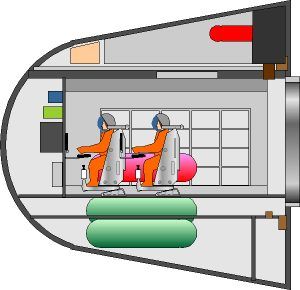 | CXV Credit: Mark Wade |
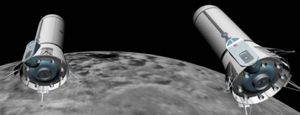 | CXV S2CEV Credit: t/Space-Mark Maxwell |
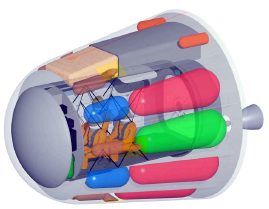 | CXV Cutaway Credit: t/Space-Tom Brosz |
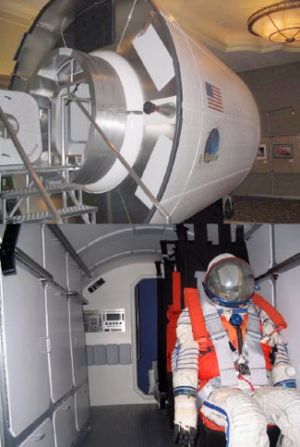 | CXV Mockup Credit: t/Space |
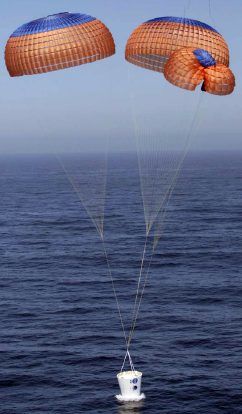 | CXV Splashdown Credit: t/Space |
Back to top of page
Home - Search - Browse - Alphabetic Index: 0- 1- 2- 3- 4- 5- 6- 7- 8- 9
A- B- C- D- E- F- G- H- I- J- K- L- M- N- O- P- Q- R- S- T- U- V- W- X- Y- Z
© 1997-2019 Mark Wade - Contact
© / Conditions for Use